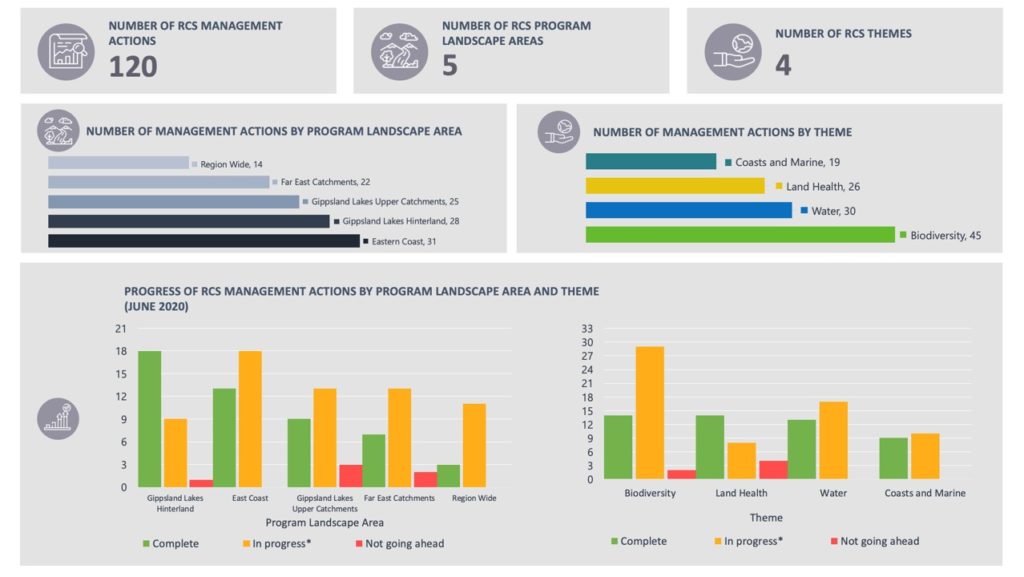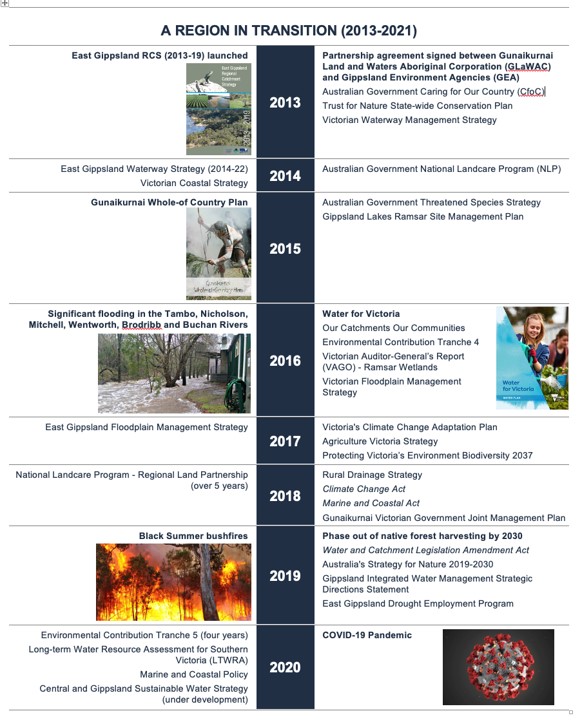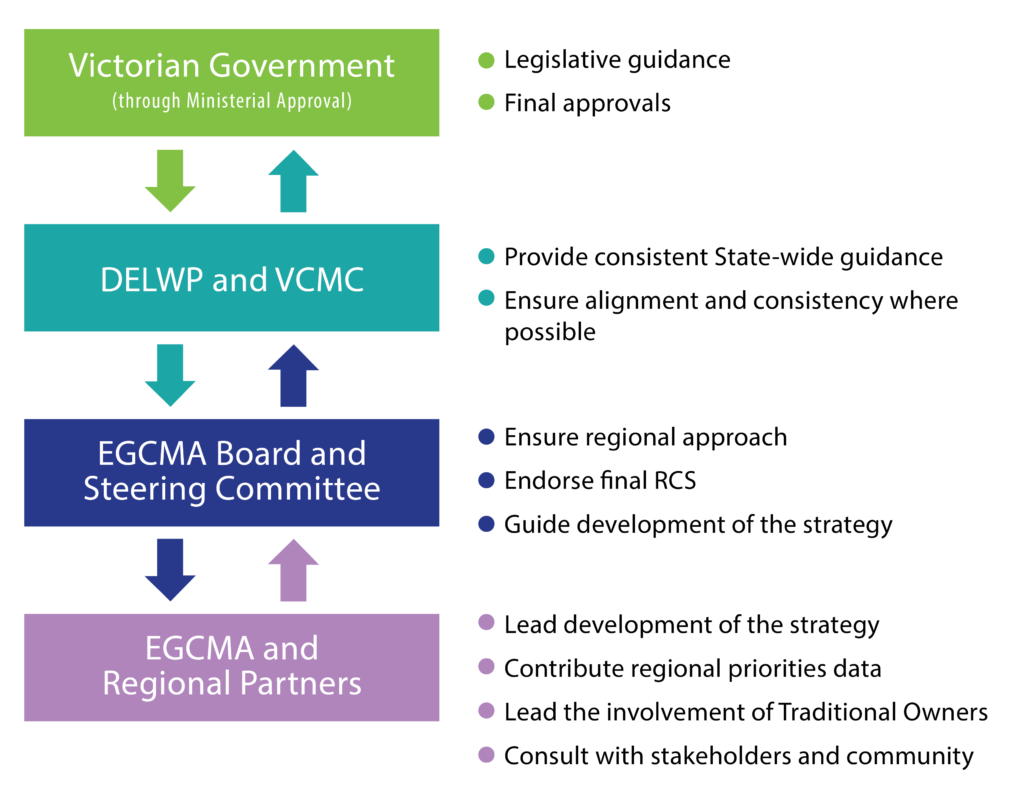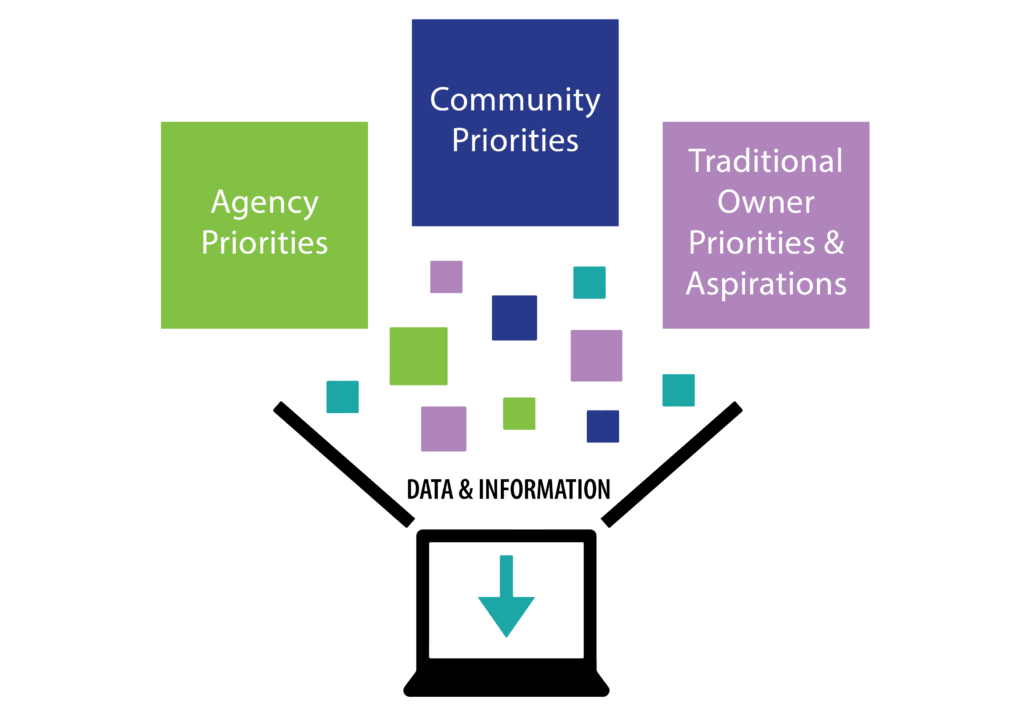- Home /
- This Strategy /
- Strategy development
The East Gippsland RCS was developed in collaboration with regional partners, including Traditional Owners, community and natural resource management organisations and agencies.
The development of this East Gippsland RCS has built on previous strategies and existing regional priorities, and plans will continue to guide natural resource management across our region.
As part of the development of the new East Gippsland RCS, a review of the previous (2013-2019) RCS was undertaken.
The Victorian Catchment Management Council guidelines specify that a review of the existing RCS should be undertaken as part of the development of the new RCS. Specifically, ‘the mid‐term and final reviews will look back to the overall effectiveness of the RCS, and forwards, with recommendations for the future’.
The East Gippsland CMA commissioned a review of the existing RCS with the aims of meeting the intent of the guidelines and helping inform the development of the new RCS for East Gippsland.
The purpose of this end of term review was to:
- Provide an update on achievements, learnings and changes since the mid-term review completed in 2016
- Identify key drivers of change key emerging trends
- Provide information to assist in the renewal of the RCS for the period 2021-2027.
The review included a summary of the findings of the mid-term review undertaken in 2016, and a semi-quantitative review of the achievement of priority management actions in the RCS.

Key findings of the review include:
- Since the development of the last RCS, a number of major events have occurred, legislative reform, and new plans and strategies introduced. These impact the management of the region into the future and influence the new RCS. The timeline below shows the key planning, policy and environmental influences on our region since the development of the last RCS.
- Regarding achievement of management actions in the current RCS, 53% are in progress (on-going actions), and a total of 42% are complete. Only 5% of the 120 actions did not go ahead. The high number of in-progress actions are on-going because of either their general nature, or as a result of no fixed end date. The dashboard below summaries achievements against targets in the previous RCS.
- Some points for consideration in the development of the new RCS include: the clear descriptions of roles in implementation across the region; encouraging greater ownership over RCS by all partners; and the consideration of new information, strategies, policies, documents when identifying priorities

The CaLP Act 1994 stipulates that each CMA must prepare a Regional Catchment Strategy (RCS) for the region, and coordinate and monitor its implementation. Each CMA prepares an RCS in partnership with local communities and partners involved in integrated catchment management.
In December 2019 the Victorian Catchment Management Council released guidelines approved by the Minister for the preparation of RCS’s across Victoria. The guidelines provide a minimum set of requirements, so that each RCS is succinct and a high-level strategy.
The development of the East Gippsland RCS was overseen by a Steering Group. This group included senior representation from the East Gippsland CMA Board and key partners including the Gunaikurnai Land and Waters Aboriginal Corporation, Agriculture Victoria, DELWP, and Parks Victoria. The group provided an opportunity for East Gippsland CMA Board members to contribute to the project, and a mechanism for broader engagement with the Board around the strategy.
The broader governance structure related to the development of the RCS is outlined in the figure below.

The themes of the RCS are based around Water; Land; Biodiversity; Coasts and Marine; and Community. It is recognised that these broad themes are inter‐connected, but they align with the way governments and other investors often plan and roll out their investment programs.
The RCS also includes a ‘Local Areas’ section to focus on the integration of the themes and related topics in a way that is relevant to local communities.
The East Gippsland CMA has been working with Gippsland environment agencies since 2018 to develop regional landscape priority areas, some of which are cross regional. These areas have formed the basis of this RCS. The areas were identified by considering strategic and collaborative opportunities informed by existing priorities and management plans. The regional landscape priority areas (‘Local Areas’) are Gippsland Lakes; Forested Foothills; Alpine Peaks; Protecting the Best – Far East Gippsland; and Red Gum Plains.

The priorities and outcomes outlined in the RCS are supported by data and information collected from national, state, and regional data sets, as well as existing strategies and plans relevant to the RCS.

Themes
The new East Gippsland RCS considers and presents information on five themes: Water; Land; Biodiversity; Coasts and Marine; and Community.
The thematic information in the RCS uses regional and statewide data to provide alignment with the agreed ‘Outcomes Framework’ for the RCS’s developed by DELWP.
It is recognised that many of the specific themes are in fact interconnected. The integration of this information is addressed through the priorities and outcomes described for each of the Local Areas defined in the strategy.
Data used to develop this section of the RCS has been drawn from a variety of sources including national and state databases collating information on things like water resources, flora and fauna records, landuse, ground cover, environmental condition assessments and population data.
Local Areas
The structure of the new East Gippsland RCS is based on five Local Areas: Gippsland Lakes; Redgum Plains; Alpine Peaks; Forested Foothills; and Protecting the Best – Far East Gippsland.
The Local Areas are the foundation for a place-based approach to priority and target setting and provide a more meaningful platform for discussion with communities and regional partners about management actions and strategic direction.
The aim of this approach is to capture the interconnected nature of the themes covered by the RCS. Priorities from key regional strategic and action plans have been collated in this part of the RCS. This includes the:
- East Gippsland Regional Waterway Strategy
- Gippsland Lakes Ramsar Site Management Plan
- East Gippsland and Gippsland Plains and Strzelecki Ranges Conservation Action Plans
- Gippsland Biodiversity Response Planning process
- East Gippsland Rural Land Use Strategy
- East Gippsland Floodplain Management Strategy
- Gippsland Regional Climate Change Adaptation Strategy
- East Gippsland Integrated Water Management Strategic Directions Statement
- Gunaikurnai Whole of Country Plan
- Gunaikurnai and Victorian Government Joint Management Plan
- Statewide Conservation Plan for Private Land in Victoria
- Greater Alpine National Parks Management Plan
- Strong, Innovative, Sustainable: A New Strategy for Agriculture in Victoria
- Cape Howe Marine Park Management Plan
- Point Hicks Marine Park Management Plan
- Beware Reef Marine Sanctuary Management Plan
It should be noted that three areas (Gippsland Lakes, Alpine Peaks and Redgum Plains) all represent ‘shared’ landscapes with adjoining CMAs. East Gippsland CMA is working with the West Gippsland CMA and the North East CMA to ensure the alignment of landscape scale priorities where possible.
The involvement of regional partners including Traditional Owners, community and natural resource management organisations and agencies in the development and implementation of the RCS is critical.
Initial broad engagement with the community based on the five themes covered by the RCS was completed using the RCS website.
After providing information on the five themes of the RCS including descriptions of the values, threats and current condition across the region, the opportunity for community and stakeholders to give feedback on their priorities and vision for the region over the life of the RCS was provided through the RCS website. A range of feedback was received from the community in this initial stage.
Initial information outlining the key values, condition, and priorities for significant landscapes across the region (‘Local Areas’ – Gippsland Lakes, Redgum Plain, Forested Foothills, Protecting the Best (Far East Gippsland) and Alpine Peaks) were drafted and provided to regional partner organisations for their review and feedback.
This information was the basis for discussion through a series of seven individual and group workshops held with partner organisations between August and September 2021.
Organisations and groups participating in these workshops included:
- Department of Environmental, Land, Water and Planning
- Parks Victoria
- East Gippsland Shire Council
- Agriculture Victoria
- Trust for Nature
- Greening Australia
- East Gippsland Conservation Management Network
- Birdlife Australia
- Landcare networks (East Gippsland, Far East Victoria, Snowy River Interstate, High Country)
- Gippsland Agricultural Group
- Agriculture industry representatives through the ‘Sowing the Gap’ Project Steering Group.
The discussions and feedback from these workshops were used to inform the vision, priority outcomes, and targets for each of the landscape areas, informed by all regional partners. Additional direct invitations for input from Southern Rural Water, East Gippsland Water and Wellington Shire Council were also sought.
Feedback from these workshops and initial community consultation through the RCS website was incorporated into the draft RCS.
The East Gippsland RCS website (www.eastgippsland.rcs.vic.gov.au) provided the primary platform for community consultation, running from early December 2021 through to the end of February 2022. Consultation on the website was supported by traditional and social media campaigns to raise awareness and encourage participation in the RCS development process.
Online consultation via the website was supplemented by face to face ‘open house’ events in Bairnsdale, Orbost, Cann River and Mallacoota held during February 2022. An additional online session was also be held to accommodate community members who were unable to attend one of the open house events.
It is recognised that the involvement and recognition of Traditional Owners across the RCS should be significant. To help achieve this, a stand-alone engagement process with Traditional Owners was developed to help document the relevant aspirations, and priorities in the RCS.
The East Gippsland CMA held positive meetings with representatives from Gunaikurnai Land and Waters Aboriginal Corporation (Gunaikurnai), Nindi Ngujarn Ngarigo Monero Aboriginal Corporation (Ngarigo Monero), and Bidwell First Nations Clans (Bidwell) to support development of content for the RCS.


